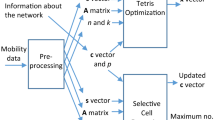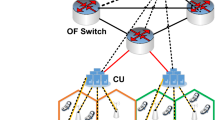Abstract
Most mobile radio networks have been planned based on the classical cellular concept. However, alternative planning strategies that lead to more efficient network configurations are necessary due to the fact that the traffic density is generally far from constant throughout the service area, making necessary the relocation of base stations inside the traffic hotspots. If the traffic is characterized in a discrete way, the optimization of base stations location resembles vector quantization, a well-known problem in signal processing. In this paper, we use this analogy to propose a mobile radio network planning algorithm. Simulation results show that higher trunking efficiency as well as improved frequency assignment can be obtained if an existing mobile radio network is redesigned using the presented strategy.
Similar content being viewed by others
References
W.C.Y. Lee, Mobile Communications Design Fundamentals, 2nd ed. (Wiley, New York, 1993).
A. Gamst and E.-G. Zinn, Cellular radio network planning, IEEE Aerospace and Electronics Systems Magazine 1 (1986) 8–11.
A. Eisenblätter, A. Fügenschuh, T. Koch, A. Koster, A. Martin, T. Pfender, O. Wegel and R. Wessäly, Modelling feasible network configurations for UMTS, Technical Report 02-16, Konrad-Zuse-Zentrum für Informationstechnik, Berlin, Germany (March 2002).
S. Hurley, Planning effective cellular mobile radio networks, IEEE Transactions on Vehicular Technology 51 (2002) 48–56.
R.M. Gray, Vector quantization, IEEE ASSP Magazine 1 (1984) 4–29.
A. Gersho and R.M. Gray, Vector Quantization and Signal Processing (Kluwer, Boston, MA, 1992).
P.C. Cosman, K.O. Perlmutter, S. M. Perlmutter, R. A. Olshen and R. M. Gray, Training sequence size and vector quantizer performance, in: Proceedings of Asilomar Conference on Signals, Systems, and Computers (November 1991) pp. 434–438.
F. Aurenhammer, Voronoi diagrams—a survey of a fundamental geometric data structure, ACM Computing Surveys 23 (1991) 345–405.
M. de Berg, M. van Kreveld, M. Overmars and O. Schwarzkopf, Computational Geometry: Algorithms and Applications (Springer-Verlag, Heidelberg, Germany, 2000) pp. 145–162.
Y. Linde, A. Buzo and R.M. Gray, An algorithm for vector quantizer design, IEEE Transactions on Communications COM-28 (1980) 84–95.
D. Hong and S.S. Rappaport, Traffic model and performance analysis for cellular mobile radio telephone systems with prioritized and nonprioritized handoff procedures, IEEE Transactions on Vehicular Technology VT-35 (1986) 77–92.
S.A. El-Dolil, W.-C. Wong and R. Steele, Teletraffic performance of highway microcells with overlay macrocell, IEEE Journal on Selected Areas Communications 7 (1989) 71–78.
K.K. Leung, W.A. Massey and W. Whitt, Traffic models for wireless communication networks, IEEE Journal on Selected Areas Communications 12 (1994) 1353–1364.
G.J. Foschini, B. Gopinath and Z. Miljanic, Channel cost of mobility, IEEE Transactions on Vehicular Technology 42 (1993) 414–424.
K. Tutschku, T. Leskien and P. Tran-Gia, Traffic estimation and characterization for the design of mobile communication networks, Technical Report 171, Institute of Computer Science, University of Würzburg, Germany (April 1997).
K. Tutschku, Demand-based radio network planning of cellular mobile communication systems, Technical Report 177, Institute of Computer Science, University of Würzburg, Germany (July 1997).
K. Tutschku and P. Tran-Gia, Spatial traffic estimation and characterization for mobile communication network design, IEEE Journal on Selected Areas Communications 16 (1998) 804–811.
A.K. Jain and R.C. Dubes, Algorithms for Clustering Data (Prentice Hall, Englewood Cliffs, NJ, 1988).
T.S. Rappaport, Wireless Communications: Principles and Practice, 2nd ed. (Prentice Hall, Englewood Cliffs, NJ, 2001).
S. Qiao and L. Qiao, A robust and efficient algorithm for evaluating Erlang B formula, Technical Report CAS98-03, L8S 4L7, Department of Computing and Software, McMaster University, Ontario, Canada (August 1998).
S. Faruque, Cellular Mobile Systems Engineering (Artech House, London, 1996), pp. 194–197.
S. Hurley, D.H. Smith and S.U. Thiel, FASoft: a system for discrete channel frequency assignment, Radio Science 32 (1997) 1921–1939.
D.H. Smith, S.M. Allen, S. Hurley and W.J. Watkins, Frequency assignment: Methods and algorithms, in: Proceedings NATO RTA SET/ISET Symposium on Frequency Assignment, Sharing and Conservation in Systems (October 1998).
J.-L. C. Wu and L.-Y. Wey, Channel assignment of cellular mobile systems with nonuniform cells, IEE Proceedings Communications 145 (1998) 451–456.
R. Chávez-Santiago, E. Gigi and V. Lyandres, Channel assignment for cellular mobile networks with nonuniform cells—an improved heuristic algorithm, IEE Proceedings Communications 153 (2006) 61–68.
A. Gamst, Some lower bounds for a class of frequency assignment problems, IEEE Transactions on Vehicular Technology VT-35 (1986) 8–14.
R. Chávez-Santiago, E. Gigi and V. Lyandres, The time complexity cost of adjacent channel interference in a heuristic for frequency assignment, in: Proceedings IEEE 2005 International Symposium on Microwave, Antenna, Propagation and EMC Technologies for Wireless Communications (August 2005), pp. 674–677.
Author information
Authors and Affiliations
Corresponding author
Additional information
Raúl Chávez-Santiago was born in Oaxaca City, Mexico. He obtained the B.Sc. degree in communications and electronics engineering in 1997 from the School of Mechanical and Electrical Engineering (ESIME-IPN), and the M.Sc. degree in electrical engineering in 2001 from the Center of Research and Advanced Studies of the National Polytechnic Institute (CINVESTAV-IPN) in Mexico City.
He has professional experience as Computer Networking Engineer, and Research and Teaching Assistant. Currently, he is completing his studies toward the Ph.D. degree at Ben-Gurion University (BGU) of the Negev, Israel. In 2002, he received the URSI Young Scientist Award. His main research interests are the optimal planning of radio communication networks, the electromagnetic compatibility of terrestrial and satellite radio systems, and the efficient use of the radio spectrum. He is an IEEE and IEICE student member, and a URSI radio scientist.
Avi Raymond was born in Yavne, Israel. He received the B.Sc. and M.Sc. degrees in electrical engineering from Ben-Gurion University (BGU) of the Negev in 2000 and 2005, respectively.
He worked for two years in a communication company in the field of Telephony and Broadband Services. He also worked as a Research Assistant in the communications laboratory at BGU. He currently works at Elta Electronic Industries Ltd. as System Engineer and pursues studies toward a second M.Sc. degree in systems engineering at the Technion Institute of Technology, Haifa, Israel. His research interests are the optimization algorithms for frequency assignment in cellular networks.
Vladimir Lyandres was born in 1944, in Vologda, Russia. He received the M.Sc. degree in communications engineering in 1966 and the Ph.D. degree in communications theory in 1972 from the State University of Telecommunications (SUT), Saint Petersburg, Russia. He was with SUT until 1990 holding a position of Senior Scientific Associate and working on research and development of digital transmission systems, modeling of radio communication channels and algorithms of frequency planning for broadcasting and cellular systems. Since 1991 he holds a position of Researcher at the communications laboratory and Professor at the Department of Electrical and Computer Engineering, Ben-Gurion University (BGU) of the Negev, Israel. His research interests include synthesis of Markov models, combinatorial optimization, and adaptive power loading. He is a senior member of IEEE and member of IEICE.
Rights and permissions
About this article
Cite this article
Chávez-Santiago, R., Raymond, A. & Lyandres, V. Enhanced efficiency and frequency assignment by optimizing the base stations location in a mobile radio network. Wireless Netw 14, 531–541 (2008). https://doi.org/10.1007/s11276-006-0735-5
Published:
Issue Date:
DOI: https://doi.org/10.1007/s11276-006-0735-5




